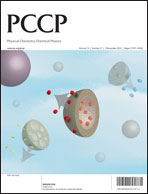Synthesis of γ-AlOOH nanocrystals with different morphologies due to the effect of sulfate ions and the corresponding formation mechanism study†
Abstract
The investigation of the metal oxide/inorganic ion interface at the atomic level represents a fundamental issue for the understanding of chemical and physical processes involved in several fields such as catalysis, adsorption, directed synthesis and the mechanistic study of crystal growth. In this paper, a combined hydrothermal synthesis and computational approach based on DFT theory is adopted to investigate the effects of sulfate ions on the final morphology of γ-AlOOH. The quantum mechanical calculations reveal that the sulfate ions interact with γ-AlOOH facets through surface hydroxyls and act as a morphology-directing agent. The adsorption type and chemical bonds between the sulfate ion and γ-AlOOH are discussed. The formation of nanosheets and nanorods of γ-AlOOH is controlled by thermodynamic factors. Moreover, the HR-TEM images reveal the growth directions and exposed planes of boehmite, indicating an oriented-aggregation process which is consistent with the DFT calculations. Overall, all the morphologies of boehmite suggested by the calculations are confirmed by experimental results.


 Please wait while we load your content...
Please wait while we load your content...